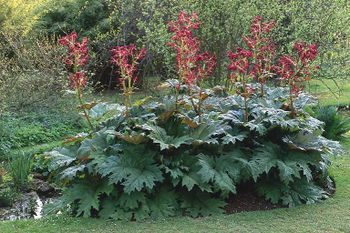Rheum Palmatum
From Wikiwel
Other names : Rheum Palmatum, Rheum Officinale, Indian Rhubarb, Chinese Rhubarb, Turkish Rhubarb, Turkey Rhubarb, Ornamental Rhubarb
See also :
Rheum Palmatum is considered a stronger medicinal than Rheum rhabarbarum.
Special Precautions of Chinese Rhubarb
- It should be noted that rhubarb, while tart and nutritious, is toxic to humans if the top leaves are consumed (only eat the red stalks, or petioles)
- Pregnant and nursing women should not use Chinese Rhubarb Root Herbal Supplement (it is a uterine stimulant)
- It should not be used by those who suffer from colitis or have intestinal obstruction
- Kidney stones : Rhubarb is high in calcium, more than a comparable cup of milk. Unfortunately, the calcium is in the form of calcium oxalate, which blocks absorption of calcium not only from the ingested rhubarb itself, but also from any other food eaten at the same time. Cooking converts the oxalic acid into an inorganic crystalline form which can build up into kidney stones. Those who tend to develop kidney stones with oxalate content should avoid rhubarb.
- Diarrhea or constipation: Rhubarb can make diarrhea or constipation worse, depending on the preparation used.
- Gastrointestinal (GI) conditions: Don’t take rhubarb if you have a bowel obstruction; appendicitis; unexplained stomach pain; or inflammatory conditions of the intestines including Crohn's disease, colitis, and irritable bowel syndrome (IBS).
- Kidney disease: There is a chemical in rhubarb that might harm the kidneys. In fact, a supplement that contained rhubarb has been linked to one report of kidney failure. If you already have kidney disease, don’t risk making it worse by taking rhubarb.
- Digoxin (Lanoxin) interacts with RHUBARB
- Medications for inflammation (Corticosteroids) interacts with RHUBARB
- Medications taken by mouth (Oral drugs) interacts with RHUBARB
- Medications that can harm the kidneys (Nephrotoxic Drugs) interacts with RHUBARB
- Stimulant laxatives interacts with RHUBARB
- Warfarin (Coumadin) interacts with RHUBARB
- Water pills (Diuretic drugs) interacts with RHUBARB
Benefits and uses of Chinese Rhubarb are
Rheum officinale is used in traditional Chinese medicine, where it is called yào yòng dà huáng (Chinese: 药用大黄), and is also a component in the North American herbal remedy called Essiac tea.
- Chinese Rhubarb Root has been used for over two thousand years as a mild, yet powerful and effective, laxative that empties the intestines and cleanses the bowels thoroughly. The anthraquinone glycosides are natural stimulants that produce a purging action, which make it useful for treating chronic constipation. At higher doses, the anthraquinone activity is throught to predominate, resulting in more watery and more frequent stools. Its mild action has been considered suitable for children (only under a doctor's supervision), and it is often used as a stool softener in the presence of anal fissures and hemorrhoids and used post-operatively for recto-anal operations. In China, it is included in some standard bowel preparation programs for colonoscopy.
- The tannins in Chinese Rhubarb Root produce astringent properties, and when taken in small doses, the tannin activity in Rhubarb supersedes the anthraquinone activity, thus leading to a lower water content of stool, and this action has been effective in relieving diarrhea. Moreover, the pectin content in Rhubarb Root is also thought to work well with tannins as an anti-diarrheal. As an effective astringent, Chinese Rhubarb Root has been used to alleviate hemorrhoids, internal bleeding and inflamed mucous membranes.
- Chinese Rhubarb Root is considered an "alterative" or agent that helps to gradually and favorably alter the course of an ailment or condition. It helps to modify the process of nutrition and excretion and restore normal bodily function, acting to cleanse and stimulate the efficient removal of waste products from the system. As such, it not only cleanses the intestinal tract and blood, but it is also thought to cleanse the liver by encouraging bile flow. The herb is also said to enhance and improve gallbladder function and relieve both liver and gallbladder complaints by releasing an accumulation of toxins.
- The bitter principle included in Chinese Rhubarb Root is said to stimulate good digestion and improve the appetite. It is considered a "stomachic" that relieves gastric disorders, improves the appetite and gives tone and strength to the stomach. Rhubarb is thought to be particularly effective in treating atonic dyspepsia, helping the digestive organs when in a condition of torpor and debility. In addition, the herb is also believed to encourage gastric flow, which also aids the digestive process.
- As an antimicrobial, Chinese Rhubarb Root has been used to treat internal pinworms, threadworms and ringworms.
- Chinese Rhubarb Root has been used to relieve menstrual problems. The herb stimulates the uterus and is thought to move stagnated blood, which also helps to relieve pains and cramps.
- Chinese Rhubarb Root is thought to possess antibacterial, antibiotic and anti-inflammatory properties, which have made it useful for both internal and external inflammation and infection (skin eruptions, boils and carbuncles, etc.) and to promote healing (wounds, cold sores and burns, etc.).
- In vitro studies, the anthraquinones in Rhubarb exhibited virucidal activity against HSV I, measles, polio and influenza virus; but thus far, no conclusions have yet been published.
